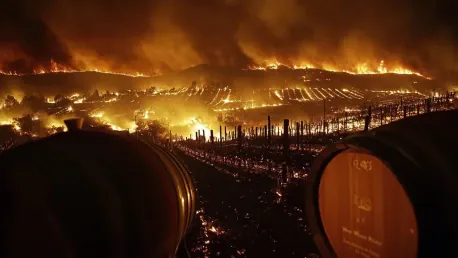Northern California wineries are grappling with the aftermath of devastating wildfires, and the path to rebuilding is fraught with nuanced challenges. As these beloved vineyards assess the damages, one crucial question looms large: Will their insurance provide enough coverage to fully recover? Many small wineries, particularly in tourist-favored regions like Napa and Sonoma, may find their insurance payouts insufficient due to policy limitations and soaring reconstruction costs post-disaster.
The Complexity of Insurance Policies
Insurance policies are notoriously complex, and this is especially true for wineries dealing with wildfire damage. While crops are typically insured, the vines themselves often are not, leaving a significant gap in coverage. Additionally, policies may include specific conditions that limit coverage, such as spoilage resulting from electrical failures not being covered under fire policies. The timing of the fires, occurring just as the harvest season was concluding, compounds the difficulties faced by wineries in maximizing their insurance claims.
Tom Pagano of Aon Plc underscored the enormity of the issue, noting that the substantial insured losses are estimated to be between $3 billion and $6 billion. Despite the high figures, these may still fall short for many affected businesses. The Napa Valley Vintners trade group reported that around thirty members had varying degrees of damage, with six wineries facing significant losses. While vineyards mostly escaped the worst as fires hit primarily the hillsides, the financial blow is nonetheless severe.
Case Study: Paradise Ridge Winery
Paradise Ridge Winery in Santa Rosa stands as a testament to the challenges and resilience faced by wineries in recovery. This winery lost crucial facilities along with thousands of cases of wine, presenting a daunting reconstruction task. However, by employing a forensic expert and a builder early in the process, Paradise Ridge has managed to take a proactive approach to rebuilding quickly. They are fortunate to have comprehensive coverage provided by Allianz and Lloyd’s of London.
The situation of Paradise Ridge raises important questions about insurance policies in the industry. Smaller wineries often lack the resources and expertise to negotiate additional coverages as thoroughly as more prominent establishments can. This discrepancy can leave them significantly more vulnerable in the wake of disasters. Despite their preparedness, the reconstruction process highlights the value of having comprehensive insurance coverage to mitigate against such extensive losses.
Underinsurance and Its Pitfalls
One of the significant pitfalls for underinsured wineries is the potential need to pay co-insurance penalties, further reducing the final payout. This additional financial strain can halt or slow the recovery process markedly, underscoring the importance of having adequate insurance. Many smaller wineries might not have comprehensive coverage, leaving them exposed to significant gaps in their payouts and complicating their rebuilding efforts.
The need for better preparedness and more thorough insurance planning becomes clear when considering the financial and operational setbacks these wineries now face. With policy limitations and increased reconstruction costs, many small businesses might be forced to cover a substantial portion of the damages out-of-pocket. The economic strain could impede their ability to fully recover, highlighting the critical need for robust risk management strategies.
The Path Forward for California Wineries
Northern California wineries are currently facing the daunting task of recovering from the aftermath of catastrophic wildfires. The road to rebuilding is fraught with complex and multifaceted challenges. As these cherished vineyards meticulously assess the extent of the damage inflicted by the fires, one pressing question becomes apparent: Will their insurance policies provide sufficient coverage to enable full recovery? This concern is particularly acute for smaller wineries, especially those located in popular tourist regions such as Napa and Sonoma. These small, often family-run wineries may find themselves grappling with inadequate insurance payouts. One reason for the potential shortfall is policy limitations, which may not account for the true cost of reconstruction. Additionally, the expenses associated with rebuilding have skyrocketed post-disaster, further exacerbating the financial strain. The combination of insufficient insurance and the high cost of restoration poses a significant challenge to the survival and future prosperity of these wineries.









